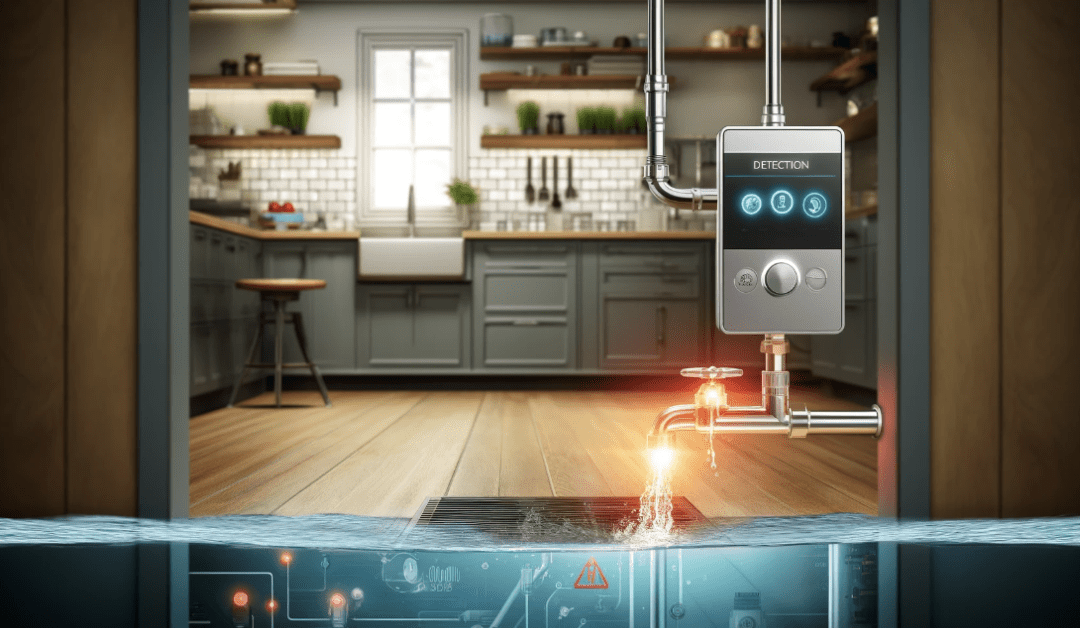No one wants to deal with a flooded basement or warped floors, but undetected water leaks can wreak havoc on your home. Mold, structural damage, and sky-high water bills are just a few of the unwelcome consequences.
The good news is, there’s a superhero for your plumbing: automatic water leak detection and shut-off systems. These smart devices can:
- Discover leaks before they cause a flood: Using advanced sensors, they can detect leaks the moment they spring, even behind walls or under floors.
- Become your home’s water shutoff valve hero: When a leak is found, the system automatically cuts off the water supply, stopping the damage in its tracks.
- Send you a leak alert: Many systems will sound an alarm or send a notification to your phone, so you can take action fast.
In this blog post, we’ll explore automatic water leak detection and shut-off systems: their workings, benefits, and how they can help you achieve ultimate home security. Get ready to learn how to keep your home safe and dry!
WHAT ARE AUTOMATIC WATER LEAK DETECTION AND SHUT-OFF SYSTEMS?
Automatic water leak detection and shut-off systems are plumbing devices designed to identify and stop leaks in your water supply lines. These systems act as guardians of your home, protecting it from the potential damage and financial burden caused by undetected leaks.
There are two main types of automatic water leak detection and shut-off systems:
1. SENSOR-BASED SYSTEMS
These systems use strategically placed sensors to detect moisture. The sensors are typically placed in areas that are prone to leaks, such as under sinks, around washing machines, and in basements. When a sensor comes into contact with water, it triggers an alarm and shuts off the water supply via a connected shut-off valve.
2. FLOW-BASED SYSTEMS
These systems monitor the flow rate of water in your pipes. They are typically installed on the main water supply line entering your home. The system continuously monitors the flow rate and compares it to pre-established thresholds. If the flow rate exceeds a certain threshold (indicating a potential leak), the system automatically shuts off the water supply. Some flow-based systems can also detect unusually low water pressure, which can be a sign of a leak outside the house.
Here are some additional points to consider:
- Some systems combine both sensor-based and flow-based detection for maximum protection.
- Many systems can be connected to your smartphone through an app, allowing you to monitor water usage remotely and receive alerts in case of a leak.
- Installation complexity can vary depending on the system. For optimal performance and safety, it is strongly recommended that automatic water leak detection and shut-off systems be installed by a licensed plumber. Even seemingly minor errors during installation can compromise their effectiveness. Plumbers have the expertise and tools to ensure both systems are installed correctly, minimizing the risk of leaks or damage to your plumbing system.
BENEFITS OF AUTOMATIC WATER LEAK DETECTION SYSTEMS
Hidden leaks can wreak havoc on your home, leading to a cascade of problems. Automatic water leak detection systems are your guardian, offering a range of benefits to keep your home safe and dry.
Here’s how these smart devices can benefit your home:
PREVENTION OF WATER DAMAGE
This is the primary benefit. Leaks, whether from faulty pipes, overflowing appliances, or unnoticed cracks, can lead to a cascade of problems. From ruined floors and warped cabinets to mold growth and structural issues, the consequences can be extensive and costly. Automatic leak detection systems identify leaks early on, allowing you to address them promptly before significant damage occurs.
COST SAVINGS ON REPAIRS AND INSURANCE
Early detection translates to significant cost savings. By catching leaks before they cause major damage, you can avoid expensive repairs and replacements. Additionally, some insurance companies offer discounts for homes equipped with leak detection systems. The upfront investment in a leak detection system can pay off handsomely in the long run.
INCREASED HOME SAFETY AND PEACE OF MIND
Water leaks damage property and can create safety hazards. Mold growth, a common consequence of undetected leaks, can pose health risks for your family. Automatic leak detection systems provide peace of mind by giving you the knowledge and control to address leaks swiftly. Imagine the comfort of knowing your home is constantly monitored for potential problems, even when you’re away.
By offering these benefits, automatic water leak detection systems become a valuable investment for any homeowner. They can save you money, protect your property, and ensure a safer, healthier environment for your family.
HOW DO THESE SYSTEMS WORK?
We’ve explored the impressive benefits of automatic water leak detection systems, but how exactly do these guardians of your home function?
Let’s delve into the inner workings of these smart devices and understand the key components that make them so effective:
THE ESSENTIAL PLAYERS:
- Sensors: These are the system’s eyes and ears, strategically placed in areas prone to leaks like under sinks, washing machines, and basements. Sensor-based systems employ moisture detection sensors that trigger an alarm upon contact with water. Flow-based systems utilize sensors embedded within the shut-off valve itself, monitoring water flow within the pipes.
- Shut-off Valve: This is the system’s muscle. It’s a valve installed on the main water supply line or specific branch lines. When the control unit receives a leak signal, it triggers the shut-off valve to halt the water flow, preventing further damage.
- Control Unit: This is the system’s brain. It receives signals from the sensors, analyzes the data, and activates the shut-off valve if a leak is detected. Some control units offer additional features like smartphone notifications, allowing you to monitor the system remotely.
THE STEP-BY-STEP RESPONSE TO LEAKS:
- Detection: A sensor that detects moisture or abnormal water flow sends a signal to the control unit.
- Analysis: The control unit analyzes the signal. In sensor-based systems, it may check for confirmation from additional sensors or a sustained presence of moisture. Flow-based systems compare the water flow data against established baselines.
- Action: If a leak is confirmed, the control unit sends a signal to the shut-off valve.
- Shut-off: The shut-off valve activates, stopping the flow of water through the affected line.
- Alert (Optional): Many systems trigger an audible alarm or send a notification to your smartphone, alerting you to the leak and allowing you to take further action.
By working in perfect harmony, these components create a powerful defense system against hidden leaks. The swift detection and automatic shut-off capabilities minimize water damage and give you the upper hand in protecting your home.
KEY FEATURES TO CONSIDER IN A WATER LEAK DETECTION SYSTEM
Automatic water leak detection systems come in a variety of configurations, each with its own strengths.
Here are some key features to consider when selecting the perfect system for your home:
SENSITIVITY AND ACCURACY OF LEAK DETECTION
This is paramount. Look for systems with adjustable sensitivity to fine-tune detection for your specific needs. High accuracy ensures you’re alerted to real leaks and not fooled by minor fluctuations.
CONNECTIVITY AND INTEGRATION WITH SMART HOME SYSTEMS
Tech-savvy homeowners may desire a system that connects to their smart home network. This allows for remote monitoring via smartphone app and integration with other smart devices, like automatically shutting off smart plugs if a leak is detected near electronics.
BATTERY BACKUP AND POWER OPTIONS
Battery backup ensures the system continues to function even during power outages. Some systems offer AC power with battery backup for added reliability. Consider the battery life and ease of replacement when making your choice.
MAINTENANCE TIPS FOR AUTOMATIC WATER LEAK DETECTION SYSTEMS
Just like any other home security device, your automatic water leak detection system requires some TLC to function optimally. Here are some regular maintenance practices to ensure it stays vigilant:
- Sensor Testing: At least once a year, test your sensors according to the manufacturer’s instructions. This may involve simulating a leak by wiping the sensor with a damp cloth for moisture detection sensors. For flow-based systems, consult the manual for any recommended testing procedures.
- Battery Replacement: If your system relies on batteries, replace them proactively before they die. Most systems will send you notifications when battery levels are low. Following this schedule ensures uninterrupted leak detection.
- Cleaning: Wipe down sensors with a damp cloth periodically to remove dust or buildup that could hinder their ability to detect leaks accurately. Avoid using harsh chemicals, as they can damage the sensors.
- Visual Inspection: Regularly check the shut-off valve and surrounding pipes for any signs of leaks or corrosion. This proactive approach can help identify potential issues before they escalate.
- App Updates: For systems with smartphone apps, ensure you keep the app updated with the latest software versions. Updates often include bug fixes and performance improvements, keeping your system functioning at its best.
TROUBLESHOOTING COMMON ISSUES
Even with proper maintenance, occasional glitches can occur. Here’s how to address some common problems:
- False Alarms: If your system triggers a false alarm, check for any recent plumbing work or changes in water pressure that might have caused temporary fluctuations. For persistent false alarms, consult the user manual. contact the manufacturer, or contact a licensed plumber for further troubleshooting steps.
- Sensor Issues: If a sensor is unresponsive during testing or malfunctions, consult the manual for troubleshooting steps. Some systems allow sensor calibration, while others may require replacing a faulty sensor.
- Connectivity Problems: If your system utilizes Wi-Fi or Bluetooth connectivity and experiences connection drops, check your router and internet connection. Restarting the system and router might resolve the issue. For persistent problems, refer to the user manual for troubleshooting tips specific to your system.
By following these simple maintenance and troubleshooting practices, you can ensure your automatic water leak detection system remains a in proper working order.
INVEST IN PEACE OF MIND
Throughout this blog post, we’ve explored the world of automatic water leak detection and shut-off systems. We’ve uncovered the dangers posed by hidden leaks, the impressive benefits these systems offer, and the inner workings that make them so effective.
Protecting our homes from preventable damage is a top priority. Automatic water leak detection systems are a powerful tool in this defense. The ability to swiftly detect and address leaks can save you from costly repairs, potential health risks associated with mold growth, and the immense stress of dealing with major water damage.
Ready to safeguard your home from the perils of hidden leaks? Landa Plumbing is your trusted partner in leak detection and prevention. Our licensed plumbers can help you choose the right system for your needs and ensure it’s installed correctly for optimal performance. Contact Landa Plumbing today for a free consultation and experience the peace of mind that comes with knowing your home is protected.

